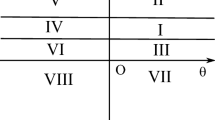Abstract
The stability of Lotka–Volterra system has been discussed by many authors for two and three species. In this paper, we will discussed the notion of stability for a Lotka–Volterra system with four species. Some criteria and results are given. Our technique depends on the Lyapunov–Razumikhin method.
Similar content being viewed by others
References
J. M. Cushing, “Forced asymptotically periodic solutions of predator-prey system with or without hereditary effects,” SIAM J. Appl. Math., 29, 665–674 (1976).
S. Elaydi, “Asymptotic stability for linear systems with infinite delay,” Comput. Math. Appl. (in press).
K. Gopalsamy, “Stability criteria for the linear system x′(t)+A(t)x(t−τ ) = 0, and an application to a nonlinear system,” Int. J. Syst. Sci., 21, 1841–1853 (1990).
B. Hernandez and V. Fairen, “Lotka–Volterra representaion of general nonlinear systems,” Math. Biosci., 140, 1–32 (1997).
B. Hernandez and V. Fairen, “Local stability and Lyapunov functionals for n-dimensional quasipolynomial conservative systems,” J. Math. Anal. Appl., 256, 242–256 (2001).
B. Hernandez, “Stability conditions and Lyapunov functions for quasi-polynomial systems,” Appl. Math. Lett. 15, 25–28 (2002).
X. Li, C. Tang, and X. Ji, “The criteria for globally stable equilibrium in n-dimensional Lotka–Volerra systems,” J. Math. Anal. Appl., 240, 600–606 (1999).
R. M. May, Stability and Complexity in Model Ecosystems, Princeton Univ. Press (1973).
R. M. May and W. J. Leonard, “Nonlinear aspects of competition between three species,” SIAM J. Appl. Math., 29, 243–253 (1975).
M. Mangel and L. Donald, “Probability of extinction in a stochastic competition,” J. Appl. Math., 33, 256–266 (1977).
R. K. Miller, “Asymptotic stability properties of linear Volterra integrodifferential equations,” J. Differ. Equ., 10, 485–506 (1971).
G. Pimbley, “Periodic solution of third order predator-prey equations simulating an immune response,” Arch. Rat. Mech. Anal., 35, 93–123 (1974).
M. R. Rama, Theory of Ordinary Differential Equations and Applications, New York (1980).
R. Redheffer, “A new class of Volterra differential equations for which the solutions are globally asymptotically stable,” J. Differ. Equ., 82, 251–268 (1989).
P. Schuster, K. Sygmund, and R. Wolf, “On ω-limits for competition between three species,” SIAM J. Appl. Math., 37, 49–54 (1979).
Y. Takeuchi, Global Dynamical Properties of Lotka–Volterra Systems , World Scientific, Singapore (1996).
Author information
Authors and Affiliations
Corresponding author
Additional information
Translated from Sovremennaya Matematika i Ee Prilozheniya (Contemporary Mathematics and Its Applications), Vol. 61, Optimal Control, 2008.
Rights and permissions
About this article
Cite this article
Soliman, A.A. Stability of Lotka–Volterra system. J Math Sci 161, 308–319 (2009). https://doi.org/10.1007/s10958-009-9554-4
Published:
Issue Date:
DOI: https://doi.org/10.1007/s10958-009-9554-4



